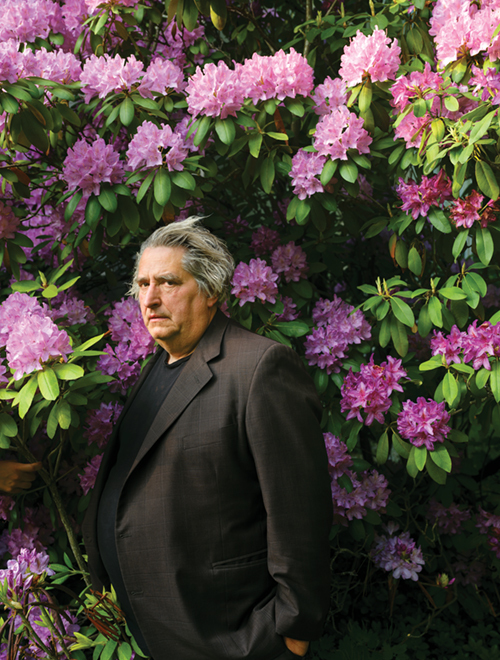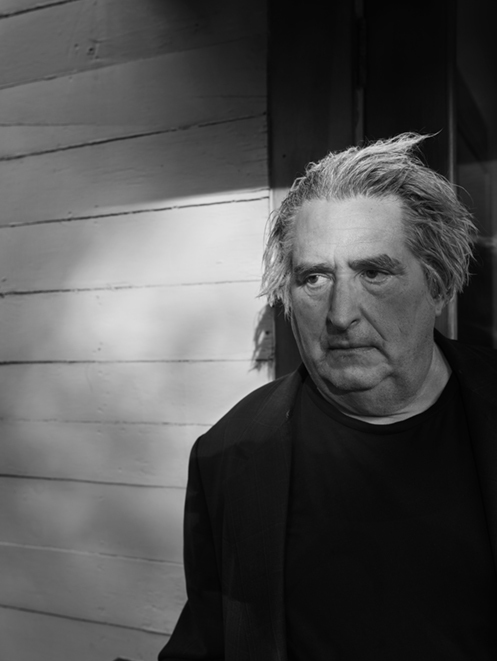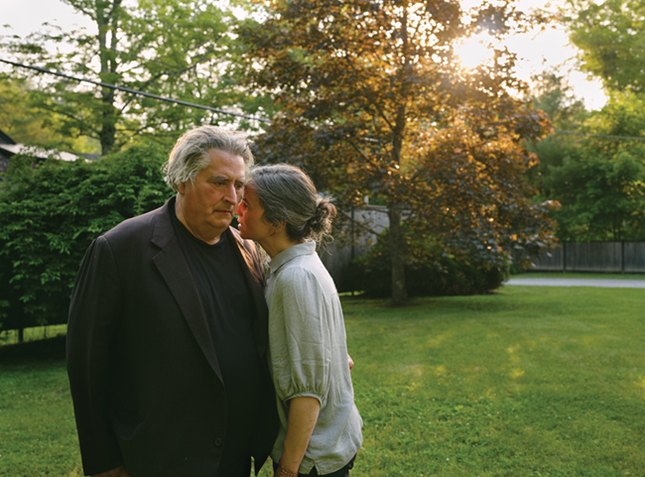
Chris Buck

Chris Buck

Chris Buck
Gregory Crewdson at his home in western Massachusetts.
View full image

Chris Buck
Gregory Crewdson at his home in western Massachusetts.
View full image

Gregory Crewdson
"Morningside Home for Women" (2021–22) is part of a series of works in black and white called Eveningside. It was Crewdson’s first use of black and white with full cinematic lighting. Crewdson’s digital prints are typically very large; this one is nearly three feet by four feet.
View full image

Gregory Crewdson
"Morningside Home for Women" (2021–22) is part of a series of works in black and white called Eveningside. It was Crewdson’s first use of black and white with full cinematic lighting. Crewdson’s digital prints are typically very large; this one is nearly three feet by four feet.
View full image
_ 2003-2008, Digital pigment print, image size 57 x 88 in_698x455_0_0_645. © Gregory Crewdson.jpg)
Gregory Crewdson
This untitled image (2003–08) is part of a body of Crewdson’s work known as Beneath the Roses. The photos were shot over the course of six productions, employing the help of more than 100 people.
View full image
_ 2003-2008, Digital pigment print, image size 57 x 88 in_698x455_0_0_82. © Gregory Crewdson.jpg)
Gregory Crewdson
This untitled image (2003–08) is part of a body of Crewdson’s work known as Beneath the Roses. The photos were shot over the course of six productions, employing the help of more than 100 people.
View full image

Gregory Crewdson
"The Haircut" (2013–14) is part of a body of work called Cathedral of the Pines, made in the town of Becket, Massachusetts, where Crewdson’s family had a cabin when he was growing up. He still goes back there to swim each day and to cross-country ski in the winter.
View full image

Gregory Crewdson
"The Haircut" (2013–14) is part of a body of work called Cathedral of the Pines, made in the town of Becket, Massachusetts, where Crewdson’s family had a cabin when he was growing up. He still goes back there to swim each day and to cross-country ski in the winter.
View full image

Gregory Crewdson
"Alone Street" (2018–19) is part of a series called An Eclipse of Moths. Crewdson and his crew worked very closely with local officials, swapping out street signs and street lamps for more dated and aged ones and pausing street paving and grass mowing. The figures were often positioned in relation to light sources, like moths finding a beacon. The series opened in 2020 at the height of the pandemic; the loneliness of the empty streets inadvertently seemed to match the global mood.
View full image

Gregory Crewdson
"Alone Street" (2018–19) is part of a series called An Eclipse of Moths. Crewdson and his crew worked very closely with local officials, swapping out street signs and street lamps for more dated and aged ones and pausing street paving and grass mowing. The figures were often positioned in relation to light sources, like moths finding a beacon. The series opened in 2020 at the height of the pandemic; the loneliness of the empty streets inadvertently seemed to match the global mood.
View full image

Gregory Crewdson
"The Lounge" (2021–22) is another picture from Eveningside. All the pictures featured here are part of a major Crewdson retrospective that originated at the Albertina Museum in Vienna. The exhibition will open at the Kunstmuseum in Bonn, Germany, on October 8.
View full image

Gregory Crewdson
"The Lounge" (2021–22) is another picture from Eveningside. All the pictures featured here are part of a major Crewdson retrospective that originated at the Albertina Museum in Vienna. The exhibition will open at the Kunstmuseum in Bonn, Germany, on October 8.
View full image

Gregory Crewdson
Writer and filmmaker Juliane Hiam (seen here with Crewdson at their home) is Crewdson’s partner in life and in work, managing his studio and collaborating on projects with him.
View full image

Gregory Crewdson
Writer and filmmaker Juliane Hiam (seen here with Crewdson at their home) is Crewdson’s partner in life and in work, managing his studio and collaborating on projects with him.
View full image
Drive through rural Massachusetts to visit Gregory Crewdson ’88MFA on a foggy spring morning and you’ll start to think you’re in one of his photographs. You’ll glide past decrepit auto shops, antique stores, and dilapidated diners, taking brief glances at anonymous figures in drugstore windows. You’ll see people trudging dutifully across the fresh lawns of public schools, tickled here and there by an eerie, almost sentient mist, framed by oaks and maples, while a modest pantheon of green mountains looms quietly in the distance. And when you arrive at his home—an 1890 Methodist church he and his life/creative partner Juliane Hiam gut renovated together, you might sense, in his stocky frame, his kindly demeanor, and his graying mop top, something reminiscent of an eighteenth-century Massachusetts statesman—John Adams, maybe? At any rate, you’ll feel as if you’ve crossed into a wonderful imaginary country where Gregory Crewdson is the president, or “the king of cinematic stills,” as Canon’s in-house magazine once called him.
The pictures he takes of his republic are more than mere photographs. Crewdson’s prints can get as large as 7x5 feet, placing the viewer in the voyeuristic, lovingly distant position of a ghost or a god. His images deliberately confound the presumption that photography always documents real events and people, because he meticulously stages every aspect of the scenery and the figures that populate it.
The photos showcase Crewdson’s painterly sense of composition and his fetish for cinematic, unsettling drama—Edward Hopper meets David Lynch. (For years, there’s been a persistent rumor that he’ll make a feature film one day; Hiam says that she and Crewdson do indeed have a streaming television series in the works.) While the shot he finally selects will often imply a narrative (especially if there’s a burning building in it) it’s hard to pinpoint what the “subjects” in them, as he calls the humans, miniaturized by their surroundings, are going through. When you can see them, their faces suggest bittersweet homecomings, momentous decisions, and wonder brought on by supernatural visitations. Sometimes all at once.
Crewdson’s process is like a film director’s in most respects; for decades he has worked with cinematographer Richard Sands (Unsinkable, Independence Day) to prepare entire municipal blocks where, over six to eight weeks, he and the Crewdson crew go about weathering billboards and creating signage to look decades old, carefully arranging multiple vintage cars, and dressing subjects in period costumes to simulate a moment outside of time. One advantage of working in the same place all the time, a place he’s been visiting since childhood, he says, is that he’s a known quantity in town, so the logistics go more smoothly than they might somewhere else.
Some call the final results romanticized, others see in it late-stage capitalist decay and elegies for the opioid crisis. Most often the final image will counterbalance intense psychology with prosaic details of exurban life in the Berkshire Mountains—sad clown paintings, floral curtains, beauty board, etc. In case that level of artifice isn’t high enough for you, Crewdson manipulates the prints in post-production so that the entire vista stays in focus—you can nearly see individual leaves on each tree.
Crewdson was raised in Park Slope by a psychiatrist father and a dance teacher mom. His grandparents were wallpaper hangers. He remembers his father engendering a crucial moment in his development by taking him to see something he might not have been prepared for. “My father brought me to see the Diane Arbus retrospective at MoMA in 1972, when I was 10 years old,” he recalls. “And this was very unusual, because we weren’t an artistic family on that level. At that point, for the first time, I had a subliminal understanding of the potential power of a picture.” Arbus’s picture of Eddie Carmel, a “Jewish giant” at home with his parents, had a particular resonance for him. “His mother and father are like, looking up at him, like, completely terrified. It’s an early lesson in dislocation of scale—the disturbance of domestic life.”
Other experiences of future relevance include songwriting and playing guitar in a teen band called The Speedies, who played legendary New York venues like CBGB and Max’s Kansas City. There, Crewdson co-penned the power punk tune “Let Me Take Your Foto,” which spawned a video of time-capsule value, filmed on the Brooklyn Heights Promenade with the Twin Towers in the background as the lead singer does his best femmed-up Bowie impression. (In 2005, the song was used in a Hewlett-Packard commercial.) At SUNY Purchase, Crewdson was drawn into a photography class by a crush, but then his transference moved from the student to the professor, who happened to be renowned artist Laurie Simmons, a Pictures Generation pioneer whose staged photos of little dolls or marionettes in pools, or surrounded by ’70s decor, helped change the photography world, alongside Cindy Sherman and Jeff Wall. (Later, Simmons became mom to Lena Dunham.)
Then photography itself became Crewdson’s love interest. “I immediately fell in love with the medium, like, from moment one,” Crewdson says. “Because I’m dyslexic . . . it made sense to me. Reading is always painful for me, and writing—just the act of writing is painful.”
Yet another inspiration showed up almost immediately, when Crewdson started taking classes with Tom Gunning, a highly influential art historian with a concentration on early and avant-garde cinema; Crewdson calls him a “genius.” (With so many professors putting gas in his engine, it seems inevitable that Crewdson would eventually take up teaching himself.)
During that time, he says, he became “entranced” with the way movies looked, particularly Hitchcock and 1950s horror films. This was right when he started photographing in western Massachusetts—a place where his family had spent time since his childhood—and socializing with mother-daughter film critics Pauline Kael and Gina James. Crewdson’s SUNY major ended up being Culture and Society, which melded photography, film theory, and American literature. In 2020, Hiam, who hails from Crewdson country, told The New York Times that his vision of Massachusetts is “the feeling a vacationer would have—the detached and enchanted view.” His Brooklyn homeboy, writer Jonathan Lethem, calls it “the city boy’s alienation at encountering the suburbs, and the edge of the woods, and the deep woods.”
Then came Yale. After a year at home, interning for Aperture magazine, Crewdson attended Yale’s School of Art from 1986 to 1988, when the department was run by Tod Papageorge, and the predominant aesthetic was documentary black and white realness of the sort perfected by Arbus and Walker Evans. “They had a very precise idea of what photography was,” Crewdson remembers, but he was also motivated by “what was going on in the New York art world.” He cites Sherman, Richard Prince, and Barbara Kruger as influences. “I always feel like my work is the coming together of their tradition of the medium with an interest in postmodernism—image culture and how pictures exist in advertising or television or film.” As for his professors at the time, “I don’t think they 100 percent got me.”
His first year of grad school, David Lynch’s film Blue Velvet showed up and changed Crewdson’s life. “That fucking blew my mind,” he says. “In terms of iconography of small towns and saturated light and flowers, I saw myself reflected somehow.” His Lynchmania in full effect, Crewdson crafted mysterious dioramas full of birds, worms, moths, and even a fox. “My first and foremost ambition always in a picture is to try to make something beautiful, but also psychologically meaningful.”
Twenty-four years later, in 2010, after teaching alongside him for 17 years, Papageorge invited Crewdson to replace him as director of the photography program at the Yale School of Art. Crewdson say that when he was a young upstart, “I always had a little bit of a tough time, but I think in the end he respected something about my work.” (To say the least, since he made him his successor.) Crewdson’s somewhat punky origin story makes it easier for Crewdson to be generous in his teaching style. “I don’t teach in a direct way. The whole thing is to try to have students finding their particular story and their particular form. It’s so different than the way we were taught. They’re so connected to the internet and social media. But the cohort shapes the program in many ways. It’s become rare now to have a physical photograph that hangs on a wall. And doesn’t move. It’s a big challenge for the students.”
One of Crewdson’s initiatives as director of the photography program is inviting and interviewing guests. He recently appeared in conversation with Oscar-winning director Bong Joon Ho (Parasite, Mickey 17). Bong was familiar with Crewdson’s work and wanted to ask him questions, but Crewdson demurred. For someone who runs the photo program at Yale and presides as the sovereign of his own mythic Massachusetts, his humility feels striking in a world that has grown so self-absorbed.
Having such a humble nature is perhaps the apex of the photographer mentality. Despite coming off a major retrospective last year in Vienna—a comprehensive show starting with his grad school work, with a gorgeous monograph to go with it—Crewdson compulsively minimizes his participation in his reputation. “All photographers are drawn to the medium by a certain voyeurism. The act of putting a camera over your eyes is, like, an act of mediation or separation. I never want to disrupt that.” He has, Lethem says, “a calm but insatiable curiosity, together with a feeling for how different arts intertwine, and how deep the resonance can be between makers of different kinds of things.” Given the way he makes his pictures, outsourcing a lot of the details to the crew, he’s free to imagine and construct his republic in a dream, free of undue concern for technical questions, not sweating the smaller problems or fussing over equipment. “I don’t even take the picture,” he says. “I don’t have a camera anymore. I don’t feel comfortable with cameras.”
 loading
loading
1 comment
-

steve giovinco, 4:23pm September 08 2025 |  Flag as inappropriate
Flag as inappropriate
The comment period has expired.classmate of greg's back in the day--he and his work was/is great, and we all knew it at the time.